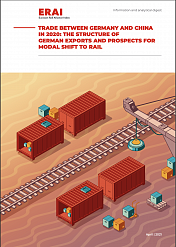The service, which facilitates the movement of goods between China and European nations, has also bolstered infrastructure connectivity, streamlined cargo transportation, and enriched trade and communication channels.
Since it began in 2011, the service has transported more than 8.7 million containers carrying goods valued in excess of $380 billion, according to the China State Railway Group, the operator of the service.
The China-Europe freight train, often referred to as a «steel camel caravan», has made these remarkable achievements in just 13 years.
The exponential growth of the service, from a few dozen trips at first to over 17,000 a year, highlights the increasing market demand for this cost-effective and reliable mode of transportation when compared with air and sea routes.
This growth has been particularly pronounced since 2016.
From 2016 to last year, the annual number of China-Europe freight train services surged from 1,702 to over 17,000, a tenfold increase with an average annual growth rate of 39.5 percent.
The initial surge to reach 10,000 journeys spanned 90 months, whereas the leap from 80,000 to 90,000 took a mere seven months.
Since May 2020, the monthly number of China-Europe freight train services has consistently exceeded 1,000.
The annual value of goods transported by the service soared from $8 billion in 2016 to $56.7 billion last year, underscoring its growing significance in international trade.
The types of goods transported by the China-Europe freight train have expanded from IT products like laptops and printers in the early stages to over 50,000 varieties of goods across 53 categories today.
On May 25, new energy vehicles were lined up at a freight railway station in Xi’an, ready to be loaded onto a customized train bound for Europe.
According to Cao Ping, who is responsible for vehicle transportation at the Xi’an Branch of the China Railway Special Cargo Logistics Co, the train, specially designed for vehicle transport, can accommodate 261 new energy vehicles per trip.
Cao added that most of the new energy vehicles shipped via the China-Europe freight train are from BYD and Geely, both of which have production bases in Xi’an.
Spreading its reach
As a crucial link in the international logistics supply chain, ensuring that the China-Europe freight train service becomes faster, more reliable, convenient, efficient, and cost-effective is paramount for its continuing success.
Today, the network of the China-Europe freight train service reaches 223 cities in 25 European countries, and connects more than 100 cities in Asia.
A new China-Europe freight train route was opened, covering over 10,000 km in about 35 days and seamlessly integrating rail and maritime transportation.
It traverses the Caspian and Black seas to reach its final destination, Salerno, Italy — offering a significantly quicker journey compared with traditional maritime routes to Southern Europe.
Need for speed
Innovations introduced to the organizational model, have cut the average transportation time between China and Europe by over five days since the commencement of operations, according to the China State Railway Group.
On May 25, a freight train loaded with 55 containers carrying a diverse range of goods, including LCD monitors, auto parts, clothing, and daily essentials, departed from Xi’an, marking the 90,000th China-Europe freight train service.
This train headed west, exiting China through the Horgos border port in Xinjiang, passing through Kazakhstan and Russia, and is expected to reach Malaszewicze in Poland within approximately 15 days.
The set-scheduled service has significantly improved transit times, with a journey from Xi’an to Duisburg, Germany, now taking only 12 days.
Five scheduled services have already been initiated from Xi’an to Duisburg, and Chengdu, Sichuan province, to Lodz, Poland, reducing travel times by 30 percent compared with regular China-Europe freight train services.
Cooperation with the Customs Department to expedite customs clearance procedures has also made the service faster.
To improve efficiency for customs clearance, it has been set up a 24-hour duty post at the station to facilitate immediate inspections upon a train’s arrival, expediting the release process. It means that no matter when the China-Europe train arrives at the border train station, it can be inspected immediately and released as soon as possible.A fter the goods arrive at the departure port, no other customs clearance procedures are required. The railway department will inspect the goods and send a report to customs through a shared system. After customs verify the information, the goods can typically be released within 10 minutes.
Overcoming obstacles
As the freight train service traverses European and Asian nations, it encounters myriad challenges, including the quest for stable sources of goods, limitations in transportation capacity, customs clearance procedures, and the intricate process of loading and unloading cargo to align with different railway tracks in different countries.
Numerous stakeholders, ranging from city governments to railway departments and customs authorities, have diligently collaborated to overcome these obstacles and enhance operational efficiency.
«China-Europe Freight Rail Service Traverses Continents, History | English.scio.gov.cn.» n.d. English.scio.gov.cn. http://english.scio.gov.cn/beltandroad/2024-06/06/content_117238552.htm.




